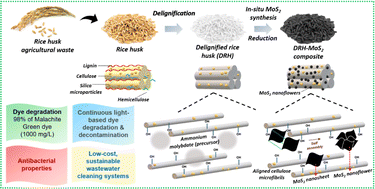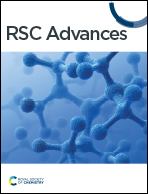Rice husk valorisation by in situ grown MoS2 nanoflowers: a dual-action catalyst for pollutant dye remediation and microbial decontamination†
Abstract
Rice husk (RH) is a common agricultural waste generated during the rice milling process; however, a major portion is either burned or disposed of in landfills, posing significant environmental risks. In this study, RH waste was transformed into bio-based catalysts via delignification cum in situ growth of MoS2 (DRH-MoS2) for efficient pollutant dye removal and microbial decontamination. The developed DRH-MoS2 exhibits nanoflower-like structures with a 2H-MoS2 phase and a narrow band gap of 1.37 eV, which showed strong evidence of photocatalytic activity. With the presence of abundant hydroxyl functionality, delignified rice husk (DRH) exhibits a malachite green (MG) dye adsorption capacity of 88 mg g−1. However, in situ growth of MoS2 nanosheets on DRH enhances MG degradation to 181 mg g−1 under dark conditions and 550 mg g−1 in the presence of light. Mechanistic insights reveal a synergistic adsorption-cum-degradation phenomenon, amplified by generation of reactive oxygen species during photodegradation which was confirmed from radical scavenging activity. Interestingly, DRH-MoS2 demonstrates potent antibacterial activity against Staphylococcus aureus (S. aureus) and Escherichia coli (E. coli) with sustained photodegradation efficiency (>80%) over three cycles. The present work reports a cost-effective and scalable strategy for environmental remediation of real wastewater which usually contains both dye pollutants as well as microbes using abundantly available renewable resources such as sunlight and agricultural biomass wastes.



 Please wait while we load your content...
Please wait while we load your content...